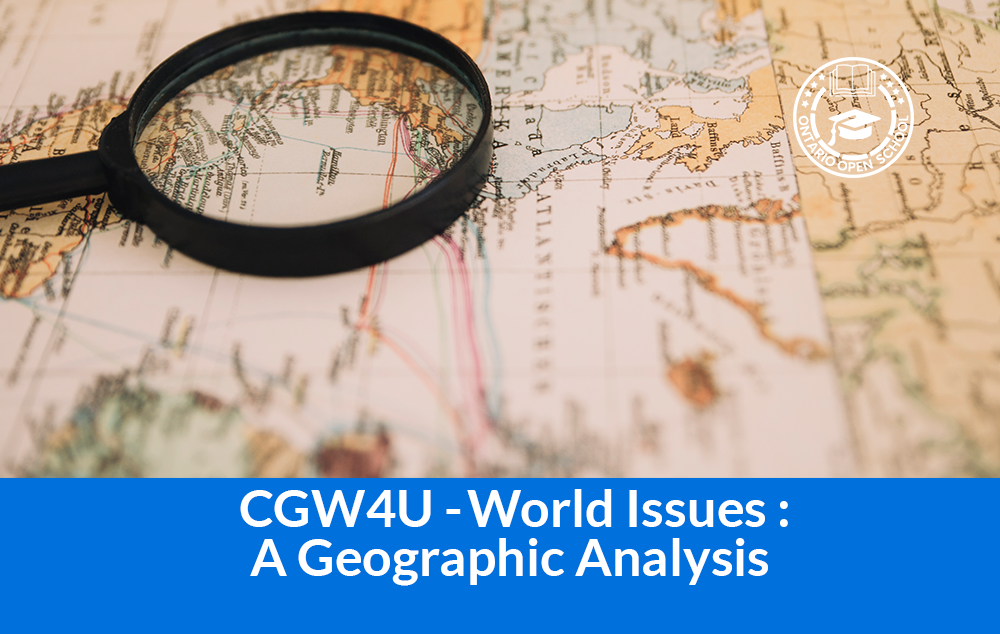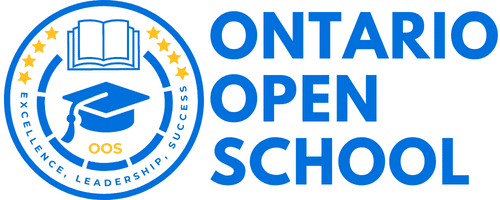- info@ontarioopenschool.com
- 647-494-4499
-
Unit 100 - 29 Gervais Drive, North York, ON.
M3C 1Y9
Copyright 2024 Ontario Open School Inc. All Rights Reserved.
In this course, students will address the challenge of creating a more sustainable and equitable world. They will explore issues involving a wide range of topics, including economic disparities, threats to the environment, globalization, human rights, and quality of life, and will analyze government policies, international agreements, and individual responsibilities relating to them. Students will apply the concepts of geographic thinking and the geographic inquiry process, including the use of spatial technologies, to investigate these complex issues and their impacts on natural and human communities around the world.
Unit Order | Unit Name | Suggested Time |
|---|---|---|
| Unit 1 | One World: This unit begins by addressing the questions; What is an issue? What makes one issue Canadian but another a world issue? And how ought the analysis of issues of these kinds be approached and carried out? Rather than plunging headlong into a detailed study of any of the issue areas covered in the course, the next section of the unit focuses on two preliminary but important matters: the basic facts of world geography today and a familiarization with westernization, modernization and globalization. | 14 hours |
| Unit 2 | The Population Factor: The unit begins with an examination of the terminology and basic tools of demography, including: population trends world-wide, evolutionary patterns of world population growth, population projections and policies. From there students will account for the rising volume of international migration around the world in recent years, the types and incidence of migration flows, impacts of international migrant flows, and international migration issues occurring in the world. After these examinations of growth and mobility the unit will focus on the third of these attributes of human population: distribution. In particular students will learn about the phenomenon of urbanization, and megacity population concentration. | 20 hours |
| Unit 3 | Economic Development: Three facets of global disparity in material standard of living are explored in this unit. These are first, its dimensions and geography; second, its underlying causes and the issues it typically gives rise to in both rich and poor regions; and third, possible remedies. Topics such as Spearman’s Rank Correlation, the Rostow Model of Economic Development, Canada’s Foreign Aid Strategy, and NGOs are covered | 20 hours |
| Unit 4 | Resources and Environments: This unit studies the role of humanity as an agent of environmental change in an attempt to help students appreciate the nature, scope and seriousness of human-induced environmental deterioration around the globe; to provide them with some historical perspective on the present status of the planetary environment; to give students opportunities to analyze specific environmental quality issues and to familiarize them with the ideas and practices of managing resources and environments according to the principles of sustainable development. | 20 hours |
| Unit 5 | One World Divided: Perhaps it is no exaggeration to say that this unit – covering the nature, dimensions, causes, consequences and possible cures of conflict – deals with the most significant set of issues in the entire course. Students will investigate a current conflict of their own choice to apply what they have learned about conflict analysis in general to a specific case study, as well as suggest courses of action that could lead to a resolution of the conflict. Major theories to be explored are: the Mackinder Hypothesis, the Homer-Dixon Hypothesis, and the Huntington Hypothesis. | 14 hours |
| Unit 6 | Canada and the World: As befits the concluding unit of any course of study, all its central concerns: population, economic development, resources and environments, and conflict analysis are brought together to provide students with a convenient summary of all that they have studied. This affords students the opportunity to apply what they have learned to imagine the future and their country’s role in its making. | 14 hours |
| Final Evaluation 30% | Final Project Final Exam | 6 hours 2 hours |
| Total | 110 Hours |
A wide variety of instructional strategies are used to provide learning opportunities to accommodate a variety of learning styles, interests and ability levels. These strategies include, but are not limited to:
Purpose
The primary purpose of assessment is to improve student learning. Assessment relates directly to the expectations for the course.
A variety of assessments for and as learning are conducted on a regular basis to allow ample opportunities for students to improve and ultimately demonstrate their full range of learning and for the teacher to gather information to provide feedback. Assessment tasks relate to the success criteria set out in lesson plans. Success criteria allow students to see what quality looks like.
Evaluation is the process of judging the quality of student work in relation to the achievement chart categories and criteria and assigning a percentage grade to represent that quality. Evaluation is based on gathering evidence of student achievement through:
Assessment for Learning – we provide feedback and coaching. Assessment FOR Learning is the process of seeking and interpreting evidence for the use of learners and their teachers to decide where the learners are in their learning, where they need to go, and how best to go there.
Assessment as Learning – we help students monitor progress, set goals, reflect on their learning
Assessment AS Learning is the process of the explicit fostering of students’ capacity over time to be their own best assessors, but teachers need to start by presenting and modeling external, structured opportunities for students to assess themselves.
Assessment of Learning – we use assessments to provide evaluative statements about student achievement. Assessment OF Learning is the assessment that becomes public and results in statements of symbols
(marks/grades/levels of achievement) about how well students are learning. It often contributes to pivotal decisions that will affect students’ future.
ASSESSMENT TOOLS
| Assessment and evaluation in this course will be continuous throughout the term and will include a variety of methods. | ||
| Assessment As Learning | Assessment For Learning | Assessment Of Learning |
|
Student Product: Learning Logs KWL Chart
|
Student Product:
Assigned Questions / Worksheet/ Homework Diagnostic Quiz |
Student Product: Unit Culminating Activities Unit Tests Independent Study Project Final Exam |
|
Observation: Self-Monitoring |
Observation:
Individual Presentation
|
Observation: PowerPoint / Poster/ Media Presentation
|
|
Conversation: Reflective Discussion and Online Communication |
Conversation:
Student Teacher Conferences Q/A Session Online Communication
|
Conversation: Student- Teacher Conferencing |
Resources
Grading
Weighting of categories
| Knowledge/Understanding | Thinking/Inquiry | Communication | Application |
| 25% | 25% | 25% | 25% |

Course Grade | Grade 12 |
|---|---|
Course Code | CGW4U |
Course Category | Canadian and World Studies |
Course Type | University Preparation |
Course Delivery | Online |
Course Duration | 8hrs |
Course Credit | 0 |
Copyright 2024 Ontario Open School Inc. All Rights Reserved.
